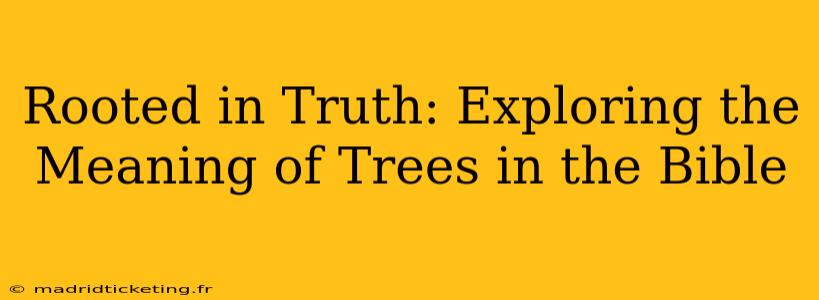Trees hold a prominent place in the Bible, far beyond mere background scenery. They represent a rich tapestry of symbolism, conveying profound spiritual truths about God, humanity, and the relationship between the two. From the Tree of Life in the Garden of Eden to the cross of Calvary, trees serve as powerful metaphors, offering insights into creation, temptation, redemption, and eternal life. This exploration delves into the multifaceted meaning of trees in the Bible, drawing connections between their symbolic significance and their appearances throughout scripture.
What do trees symbolize in the Bible?
Trees in the Bible symbolize a wide range of concepts, often depending on the context. They can represent:
- Life and Growth: The inherent growth and strength of trees often parallel human life, spiritual growth, and God's provision. The flourishing of a tree reflects God's blessing and abundance.
- Strength and Stability: Mighty trees, like cedars, are frequently used to symbolize strength, stability, and enduring power, often representing God himself or righteous individuals who stand firm in their faith.
- Wisdom and Knowledge: The Tree of Knowledge of Good and Evil, though associated with temptation, also points towards the pursuit of knowledge and understanding, albeit with consequences.
- Beauty and Blessing: Fruit-bearing trees are frequently mentioned as symbols of God's blessings, abundance, and the beauty of creation.
- Judgment and Punishment: Withered or barren trees can symbolize judgment, punishment, or the consequences of sin and disobedience.
- Shelter and Protection: Trees provide shade and refuge, mirroring God's protective presence in the lives of believers.
- Eternal Life: The Tree of Life symbolizes immortality and the promise of eternal life with God.
What is the significance of the Tree of Life in the Bible?
The Tree of Life, mentioned in Genesis 2:9 and Revelation 22:2, is perhaps the most well-known symbolic tree in the Bible. It represents immortality and access to God's presence, signifying the perfect relationship between God and humanity before the Fall. Its exclusion from humanity's reach after the Fall highlights the consequences of sin and the separation between God and humanity. However, Revelation offers hope, depicting the Tree of Life in the New Jerusalem, accessible to those who have overcome and received eternal life through faith in Christ.
What is the significance of the Tree of the Knowledge of Good and Evil?
The Tree of the Knowledge of Good and Evil, also found in Genesis 2, carries a different weight. It represents humanity's choice and the consequences of disobedience. By eating from this tree, Adam and Eve chose to disobey God's command, resulting in the Fall and the introduction of sin into the world. This tree isn't a symbol of evil itself, but rather a representation of the temptation to defy God's authority and seek knowledge independently.
Are there different types of trees mentioned in the Bible with unique symbolism?
Yes, the Bible mentions various types of trees, each with subtle nuances in their symbolism:
- Olive Tree: Often represents peace, prosperity, and God's blessing.
- Fig Tree: Symbolizes nourishment, provision, and sometimes deceit (depending on the context).
- Vine: Represents Christ and the connection between believers and God, with the branches symbolizing individuals connected to the vine.
- Cedar Tree: Represents strength, majesty, and enduring power, often linked to God's sovereignty.
What is the symbolic meaning of the cross in relation to trees?
The cross, upon which Jesus was crucified, takes on profound significance as a tree-related symbol. While seemingly representing death and suffering, it ultimately embodies redemption and new life. The cross, a tree of death, becomes the tree of life through Christ's sacrifice, offering forgiveness of sins and the promise of eternal life. This transforms the symbolic meaning of trees, highlighting the triumph of life over death.
How are trees used as metaphors in biblical parables?
Trees frequently appear in biblical parables, extending their symbolic usage. The parable of the mustard seed, for example, uses the small seed growing into a large tree to illustrate the kingdom of God's unexpected growth and influence. Other parables might utilize trees to symbolize the nature of righteousness, faithfulness, or the consequences of unfruitful lives.
What are some examples of trees in the Bible that illustrate the relationship between God and humanity?
The relationship between God and humanity is often portrayed through trees. The Tree of Life in the Garden of Eden showcased the perfect communion before the Fall. The barren fig tree in the parable of the fig tree (Luke 13:6-9) demonstrates God's patience but also the consequences of unfruitfulness. The cross, as discussed earlier, serves as the ultimate illustration of God's love and sacrifice for humanity's redemption.
In conclusion, trees in the Bible are not merely decorative elements. They are richly symbolic representations of various spiritual truths, conveying God's nature, humanity's journey, and the promise of redemption and eternal life. Their varied depictions, from life-giving to life-taking, underscore the complexity of the human experience and the unwavering power of God's love. Understanding these symbols deepens our appreciation of the biblical narrative and its enduring relevance to our lives.

